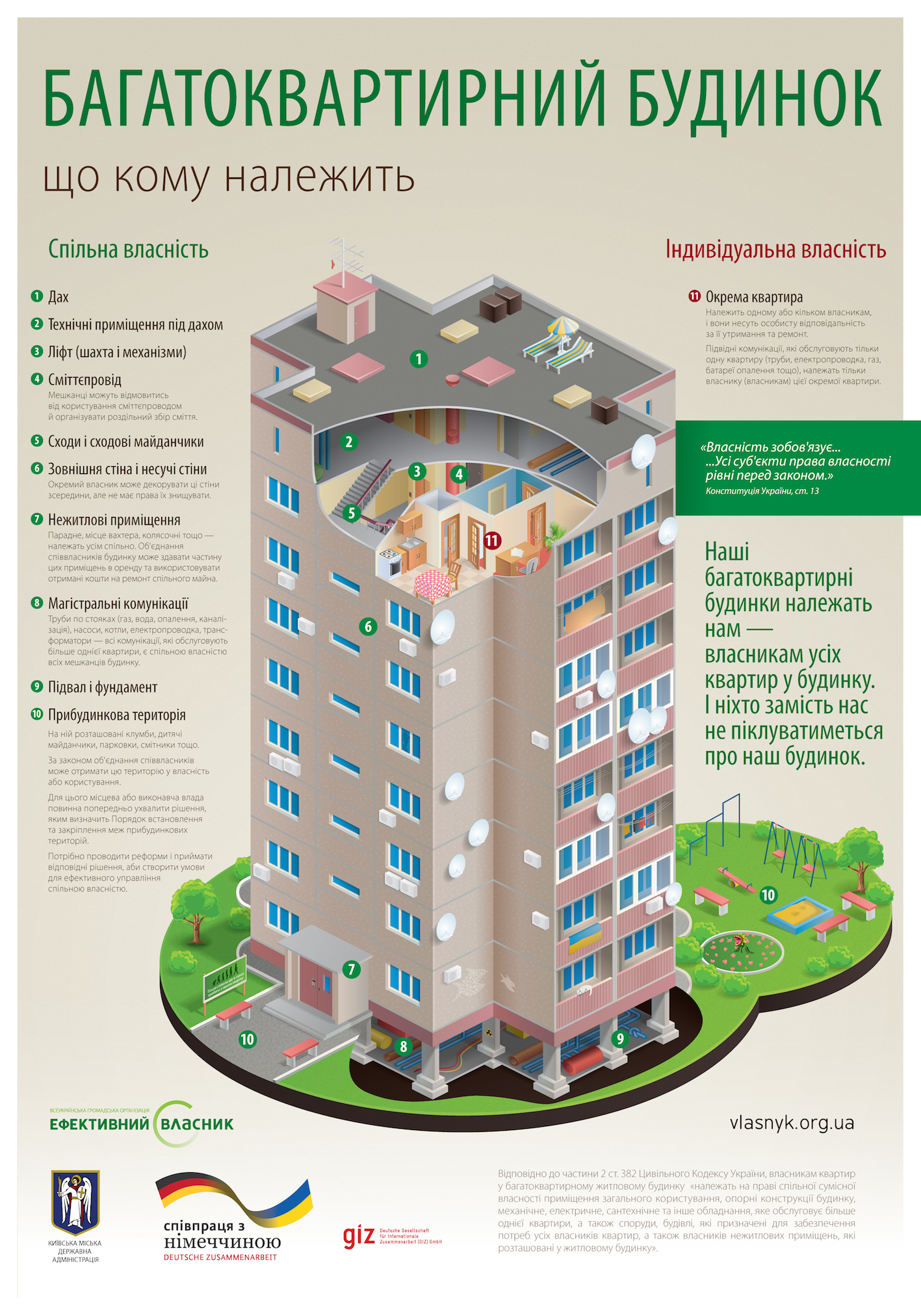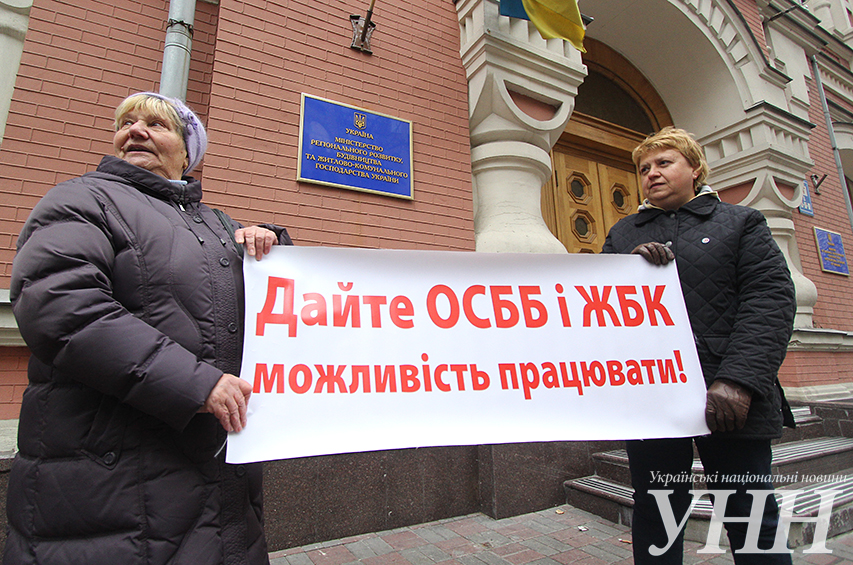We continue publication of Yegor Vlasenko’s paper «The Retreat of the State: Liberalisation of the Housing Market in Ukraine». This publication has been prepared during the Master’s program in Urban Studies at the University of Malmö through the Swedish Institute (SI) scholarships.
Housing owners associations are traditionally weak in Ukraine. Why nobody forces co-owners of apartment housing to self-organise, and why those owners do not see rational incentives for such self-organisation? How co-ownership of apartment housing is managed in other countries? Is OSBB the only possible mechanism for management of common property in a multi dwelling housing? The answers to these questions are to be discussed in the second part of the article about the retreat of state from the housing market in Ukraine.
Massive apartment privatisation in 1990s has drastically changed the ownership structure of housing stock in Ukraine. However, housing maintenance remained an issue, since the rent and household utilities pricing policies did not significantly change. In the same time, the housing system passed through a radical transformation from overly centralised into piecemeal and chaotic. In a situation when no property rights effectively define who can use the common-pool resources in multiple apartment dwellings and regulate this use, a common-pool resource is under an open-access regime (Chen, 2009), which often causes quicker deterioration and wasteful usage of this resource.
While the profile housing ministry remained at place, along with the public property management industry, the housing system in Ukraine de-facto became deinstitutionalized. For instance, an obvious failure to regulate use of shared property and public spaces in apartment housing, which houses 80% of the country’s population, was caused by absence of legal and organizational mechanism of interaction between owners of private apartments and organisations that provide household services and supply public utilities. This function was temporarily and mostly unsuccessfully split between remains of public housing companies, public and private energy companies and local authorities. With this in mind, for more than a decade Ukrainian governments are making attempts to promote a condominium as a housing system that would effectively solve the challenges of housing maintenance.
A condominium form of housing ownership provides a mechanism of regulation of access to common facilities in a multiple unit dwelling, thus helping residents to agree on mutual management and exploitation of hallways, heating system, elevators and exterior areas under legal rights associated with the individual ownership. Unlikely to cooperative form where a resident purchases stock in the housing corporation that owns the apartment building, condominium is a less corporatized ownership form and is primarily associated with ownership of an individual parcel of real property. Each owner of an individual condominium owns an undivided interest in the common area and shares the common charges for its maintenance. Condominiums are quite widespread in many countries, from the US to China, which allows an attempt to generalise benefits and disadvantages of this ownership form beyond specific national legislation. It is however interesting to mention that regulations in post-socialist countries, such as Slovakia, Romania, Estonia, Belarus and Moldova, mostly leave adopting condominium or similar ownership forms to voluntary initiative of the residents of multiple units dwellings, while similar regulations are almost always legally binding in Western Europe (Serdiuk & Kravchuk, 2013).
On the positive side, condominiums do help to achieve sustainability of institution in common-pool resources. They provide institutional design principles helping to clearly define property boundaries, introduce tools for monitoring of common resources and conflict resolution. Also, condominiums allow making effective arrangements regarding energy supply and housing maintenance services with external subcontractors. On the negative side, being an exclusively market-based ownership form does not allow condominiums to be treated as a universal solution, especially for more vulnerable population groups.
It is known that European practices of managing publicly owned houses can be divided into predominantly North-West European public housing and predominantly Southern European social housing (Magnusson & Turner, 2008). Conversion of public rental housing into market forms (condominium or cooperative housing) in both regions in 1990s often resulted into gentrification of centrally located neighbourhoods, segregation of their population and establishment of various discriminatory practices regarding membership in condominium or cooperative housing. For instance, such conversion carried out in Stockholm in the early 1990s has speeded up and reinforced the gentrification process in the inner city, with individuals with higher disposable incomes and higher levels of education replacing individuals with fewer resources (Andersson & Turner, 2014). Hence, we can draw a conclusion that this ownership form, if implemented at a massive scale, triggers negative externalities of neoliberal transformation of cities and deepens social inequalities in a spatial dimension.
On the other hand, attempts to preserve social benefits and subsidies for condominium owners do not allow creating an effective service market. For instance, government’s price-capping policy for housing maintenance in China, originally aimed at reducing the nominal cost of housing services, made the privatized housing estates stuck into poor services (Chen, 2009). Absence of competition made private companies reluctant to enter this market, so the maintenance mostly remained dependent on public housing management offices that used to manage this housing stock for decades.

Returning to the Ukrainian case, it is important to highlight the fact that condominiums here are viewed not just as a way to organise external and internal regulation of housing maintenance, but also to preserve and renovate the housing stock, 80% of which is dependent on worn-out infrastructure that experienced no renovation since the collapse of the USSR. There is also a political factor in favour of promoting condominiums, related to energy security of the country in the light of unreliable gas supply from Russia used for households heating. Due to flaws of Soviet-period construction, the majority of housing stock of 1960-80s massive housing programmes is defined by very poor energy efficiency. Since optimizing energy consumption through installing insulation or renovating pipes requires joint efforts of dwellers, condominium makes a useful ownership form for arrangements between apartment owners and state initiatives in the field of energy efficiency.
With everything mentioned in mind and taking a disproportionally high share of privatised apartments in the overall housing stock, it would be logical to expect the share of condominiums in Ukraine to be higher than European average. However, the actual numbers show that condominiums have not yet become a universal, or even popular. In particular, the State Programme on Reforming of Housing Utilities in 2009-2014 mentioned 45.5 thousands of condominiums as a target for 2014, while the actual number reached only 16.5 thousands, or less than 12% of overall number of multiple apartment dwellings. The reason for this failure dates back to housing privatization in the 1990s, while some behavioural challenges of condominium establishment should be viewed in relation to earlier socialist-era housing policy.
While the state legislation on housing privatisation came into force with the respective Law of Ukraine on Privatisation of Public Housing Stock of 1992, it remained unclear how to organise housing maintenance. Meanwhile, public housing companies remained responsible for maintenance and even renovation of privatised housing stock and kept all the blueprints and technical documentation for building maintenance. This discrepancy between actual ownership and responsibility for maintenance created a fake illusion of state control over condition of privatised housing, thus freezing all needed renovation works for years. Eventually, condominiums became more popular due to a very vivid inability of public housing companies to provide needed services and their reluctance to dwellers’ complains.
It also should be mentioned that peculiarities of functioning of public housing companies in the Soviet times created a very powerful connection with apartment housing. Apart from routine maintenance, housing companies (so called housing exploitation departments or ЖЕУ) were responsible for ideological work, cultural activities and leisure. Historically these entities were affiliated with the Ministry of Interior and also served as state registration focal points, issuing passports and residence registrations, even after this affiliation was cancelled. This vivid presence of the state made many dwellers willing to escape this surveillance, which resulted into reluctance of the majority during private housing associations establishment. Citizens of the Soviet Union stayed out of control of their housing throughout the XX century, excluding a brief period of cooperative housing movement within the New Economic Policy (NEP) in 1920s, so self-organisation within the privatized apartment system proved to be a challenging task for them.
Additionally, the national legislation on condominiums and housing associations contained a number of flaws. Firstly, while in-house common areas and resources were easy to register, external public spaces proved to be an issue, due to bureaucratic registration process and, somehow, due to modernist town planning — Soviet microrayons with freestanding buildings and absence of clear streets and inner yards made delineation difficult both for legal matters and human perception. As a result, external public spaces and street furniture became quickly deteriorated, occupied by illegal construction and parking lots. Even those multi apartment dwellings where condominium ownership was established often lacked necessary documents for maintenance of external resources, with less than 2% of such areas staying under control of condominiums by the end of 2014.

Also, the basic Law of Ukraine on Associations of Apartment Housing Owners (ОСББ) contained a lot of regulations that made establishment of condominiums very troublesome, since any decision could be easily blocked by the minority of reluctant dwellers. With amendments to this law adopted only in 2015, as well as adoption of additional Law of Ukraine on Peculiarities of Apartment Ownership in a Multiple Dwelling House of 2015, these barriers were partially removed. Most importantly, the new regulation helped to prevent exclusion of certain apartment owners from housing associations, in the same time allowing tenure form change with majority of votes. The recent legislation also made public housing companies responsible for passing all necessary legal and technical documents to newly created condominium owners associations. Also, with this legislation the state created gentle yet strong incentive for establishment of condominium tenure. For instance, those multiple dwelling houses whose residents fail to create an association will have to use services of providers picked by the local authorities.
However, perhaps the most important incentive for development of condominiums is financial. In 2014 the government made a decision to substantially cut the subsidies that remained from a socialist low-rent policy. As mentioned above, introducing a market based utilities and other housing services helps to create a competitive market for these services, thus providing necessary maintenance and renovation. However, there is still a risk that on early stage the market will still be dominated by existing public housing companies, as well as private companies affiliated with real estate development industry. Surprisingly, dwellers of newly constructed apartment houses often tend to be even less likely to adopt condominium tenure, relied on maintenance services provided by the developer. At the moment it remains unclear whether the government will be able and willing to prevent monopolization of utilities market.
As mentioned, one of central issues related to private housing in Ukraine is related to renovation and improving energy efficiency. While other Eastern European countries such as Poland, Czech Republic and Hungary have proved to be successful in terms of creation of specialized financial services for housing renovation matters, this industry is almost non-existent in Ukraine. The success of Polish PKO Bank Polski SA, which managed to provide over 30 thousands loans to Polish condominium owners associations between 2005 and 2011, fully relied on macroeconomic factors and market interest rates. As described above, Ukraine is experiencing one of the toughest economic crises in its modern history, so there is little hope that a paralyzed banking industry will be able to come up with necessary services at affordable cost. In such circumstances, role of the government might become crucial in arranging such financial conditions with international institutions, such as IFC, World Bank and EBRD.
Additionally, direct governmental funding of such projects might prove to be much more efficient than cost of subsidizing of housing maintenance and renovation, which results into financial losses of public housing companies equal to 6.3% of country’s GDP. According to IFC and EBRD experts, the overall cost of housing renovation and thermo modernization in Ukraine exceeds 5 bn Ukrainian hryvnyas (190 mln EUR), while annual state contribution is ten times lower. In the roadmap proposed by IFC and EBRD, a number of important regulations changes are recommended to allow international institutions to provide low interest loans in Ukrainian national currency to local banks. Also, a recent Cabinet of Ministers’ decree secures up to 30% percents of state contribution for loans related to thermo modernization of housing. Introduction of non-profit revolving funds able to raise funding for housing renovation and modernization projects remains another possible option that is yet to be explored.
Yet, all mentioned funding schemes become possible only given an initiative coming from the apartment owners. According to survey conducted by civil network OPORA, more than 60% of Ukrainian private apartment owners are ready to invest their personal funds into renovation of their houses. However, this hopeful statistics is being overthrown by inflation, rapid decrease of real wages and removal of utilities subsidies. While some investments related to improving energy efficiency might eventually pay off through reduced energy bills, some other costly renovation, such as roof repairs, solely lay on the dwellers.
Finally, as mentioned previously condominiums represent a market based solution and serve as no replacement for social housing. While the official share of publicly owned social housing in Ukraine is quite low, there is a substantial slice of privatised apartments inhabited by vulnerable population groups, particularly elderly people. Vast majority of building constructed in 1960s and 1970s (over 72 mln of square meters) require urgent renovation. As of 2012, 118.6 thousands people lived in houses that required complete renovation or even demolition and were in hazardous condition (Pinchak, 2013). Establishment of condominium owners associations in such houses would make inhabitants solely responsible for improving their living condition, which is of course impossible. Meanwhile, the state social housing construction is still based on ineffective Soviet queue principle — there were more than 1.022 families on the waiting list for the social housing in 2012, while the actual annual construction capacity stayed at 7-11 thousands apartments in 2009-2012 (Pinchak, 2013), and was almost completely frozen in 2014.
It is worth mentioning that constructing a rental housing, both public and private, carries substantial financial risks that, if applied to rents, would make rental housing less affordable than rent prices on the black market, based on sunk construction costs of privatised apartments (Bukiashvili 2009). With this in mind, market based housing renovation projects, for example purchasing of privatised apartments from dwellers followed by their demolition and construction of rental housing might create negative externalities related to so called renoviction (renovation + eviction) effect.
As we see, the emergence of housing market with a dominant share of privatised housing no longer allows centralised state planning, limiting its influence to regulation and allocation of subsidies and benefits. In presence of a substantial share of deteriorating housing stock the state policy of promoting self-organisation of their dwellers simply contradicts the economic logic and makes more better-off dwellers vote with their feet, provoking further marginalization of their inhabitants. In order to see possibilities and limitations of state intervention in a free market condition, the last part of this paper is devoted to analysis of the housing market in Ukraine.
Bibliography and references
- Andersson, R. & Turner, L. M. (2014). Segregation, gentrification, and residualisation: from public housing to market-driven housing allocation in inner city Stockholm. [Digital version]. International Journal of Housing Policy, vol. 14 nr. 1 s. 3-29.
- Baeten, G. & Listerborn, C. (2015) Renewing urban renewal in Landskrona, Sweden: pursuing displacement through housing policies, Geografiska Annaler Series B: Human Geography, vol. xx
- Бережна А.Ю. Приватизація житлового фонду і формування ринку житлово-комунальних послуг // Комунальне господарство міст, науково-технічна збірка № 87, 2009
- Букiашвілі В. О. ЖИТЛОВА ПОЛІТИКА ЯК ЕЛЕМЕНТ СОЦІАЛЬНОЇ ПОЛІТИКИ ДЕРЖАВИ: АНАЛІЗ ВІТЧИЗНЯНОГО ТА ЗАКОРДОННОГО ДОСВІДУ // ЕКОНОМІКА БУДІВНИЦТВА І МІСЬКОГО ГОСПОДАРСТВА, ТОМ 5, НОМЕР 3, 2009, с. 141-146
- Chen, L. (2008). Challenges of Governing Urban Commons: Evidence from Privatized Housing in China. Conference Paper, Governing Shared Resources: Connecting Local Experience to Global Challenges, the Twelfth Biennial Conference of the International Association for the Study of Commons.
- Florida, R. (2005). The Flight of the Creative Class, Harper Collins Publishing
- Gentile, M. (2015) The «Soviet» factor: exploring perceived housing inequalities in a midsized city in the Donbas, Ukraine. Urban Geography, 36:5, 696-720, DOI: 10.1080/02723638.2015.1012363
- Giucci, R., Kirchner, R., Voznyak, R. (2008). The Housing Construction in Ukraine: Reasons for the Current Recession and Policy Implications. German Advisory Group, Institute for Economic Research and Policy Consulting, Policy Paper Series.
- Giucci, R., Kirchner, R., Yuzephovich, I., Suchok, I. (2007). The Housing Prices in Ukraine: Trends, Analysis and Recommendations for the Economic Policy. German Advisory Group, Institute for Economic Research and Policy Consulting, Policy Paper Series.
- Glaeser, E. (2011). Triumph of the city: How our greatest invention makes us richer, smarter, greener, healthier and happier. Pan Macmillan.
- Harvey D. (2012), Rebel Cities: From the Right to the City to the Urban Revolution, Verso Books
- Kährik, A., Tammaru, T. (2010) Soviet Prefabricated Panel Housing Estates: Areas of Continued Social Mix or Decline? The Case of Tallinn. Housing Studies, 25:2, 201-219, DOI: 10.1080/02673030903561818
- Magnusson, L. & Turner, B. (2008) Municipal Housing Companies in Sweden — Social by Default, Housing, Theory and Society, 25:4, 275-296, DOI:10.1080/14036090701657397
- Marcuse, P. (2009) From critical urban theory to the right to the city, City: analysis of urban trends, culture, theory, policy, action, 13:2-3, 185-197,
- Ong, R., Parkinson, S., Searle, B. A., Smith, J. S., Wood, G. A. (2013) Channels from Housing Wealth to Consumption, Housing Studies, 28:7,1012-1036, DOI:10.1080/02673037.2013.783202
- Пинчак Л.А. Жилищный фонд Украины: состав, структура, статистика // Вестник МГСУ. 2013. No 9. С. 118–124.
- Renaud, B. M. (1996). Housing Finance in Transition Economies: The Early Years in Eastern Europe and the Former Soviet Union. Policy Research Working Paper. The World Bank, Financial Sector Development Department.
- Sager, T. (2011) Neo-liberal urban planning policies: A literature survey 1990–2010, Progress in Planning 76 (2011) 147–199
- Сердюк Т.В., Кравчук Г.В. ОСББ як чинник реформування житлово-комунального господарства // Економічний простір, № 76, 2013
- Smith, S. J. (2014) Neo-liberalism: Knowing What’s Wrong, and Putting Things Right, Housing, Theory and Society, 31:1, 25-29, DOI: 10.1080/14036096.2013.839277
- Smith, S. J. (2011). Home Price Dynamics: a Behavioural Economy? Housing, Theory and Society, 28:3, 236-261.
- Smith, S. J. (2011) Housing Economics: the Heterodox Experiment, Housing, Theory and Society, 28:3, 300-304, DOI: 10.1080/14036096.2011.599180
- Smith, S. J., Munro, M. (2008) The Microstructures of Housing Markets, Housing Studies, 23:2, 159-162, DOI: 10.1080/02673030801959361
- Smith, S. J., Munro, M., & Christie, H. (2006). Performing (housing) markets. Urban Studies, 43(1), 81-98.
- Smith, S. J., Searle, B. A. (2008). Dematerialising Money? Observations on the Flow of Wealth from Housing to Other Things, Housing Studies, 23:1, 21-43, DOI: 10.1080/02673030701731225
- Stryuk, R.J. (1996). Economic Restructuring of the Former Soviet Bloc. The Case of Housing. The Urban Institute Press, Washington DC. State
- Statistics Service of Ukraine, ukrstat.gov.ua
- The Right to Adequate Housing, Fact Sheet no. 21, UN Habitat
- Tsenkova, S., Turner, B. (2004) THE FUTURE OF SOCIAL HOUSING IN EASTERN EUROPE: REFORMS IN LATVIA AND UKRAINE, International Journal of Housing Policy, 4:2, 133-149



